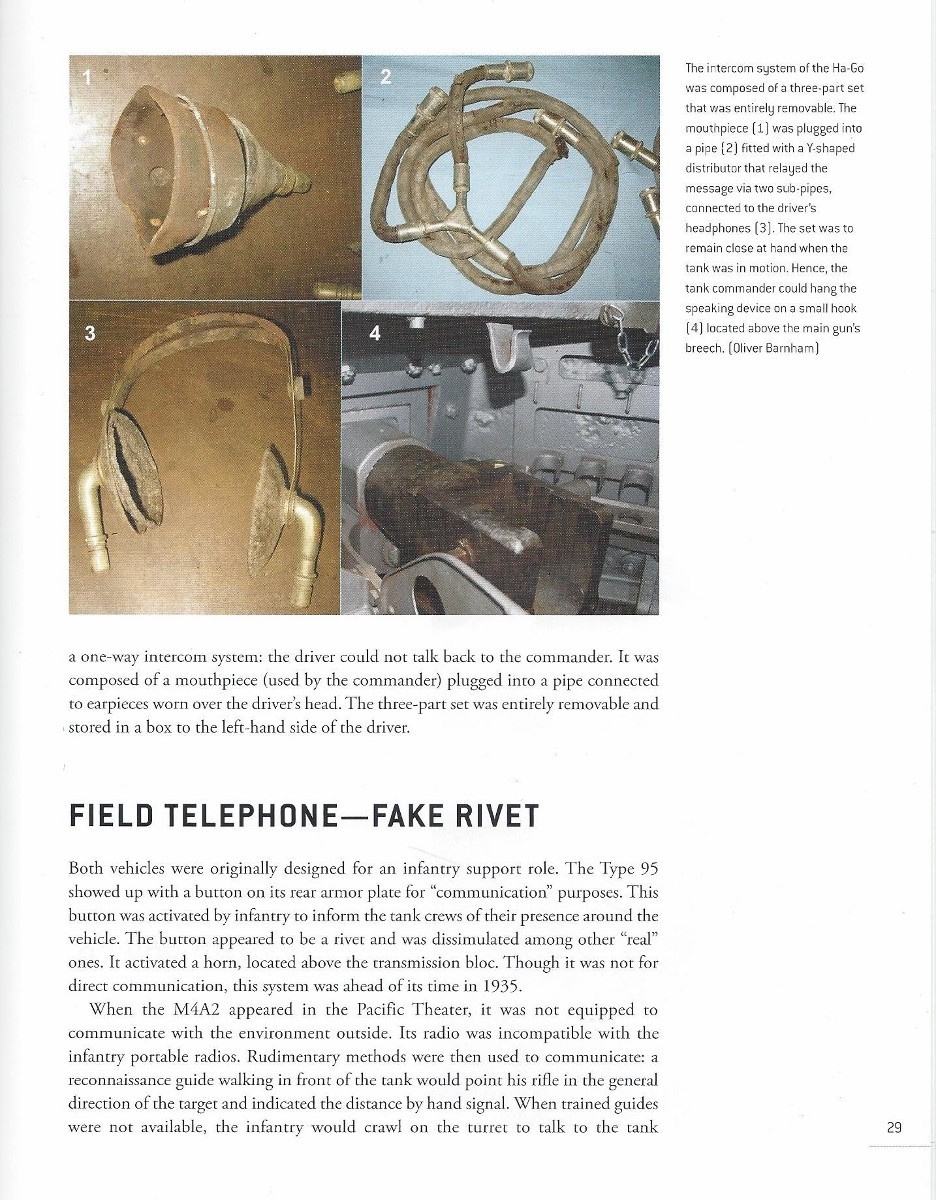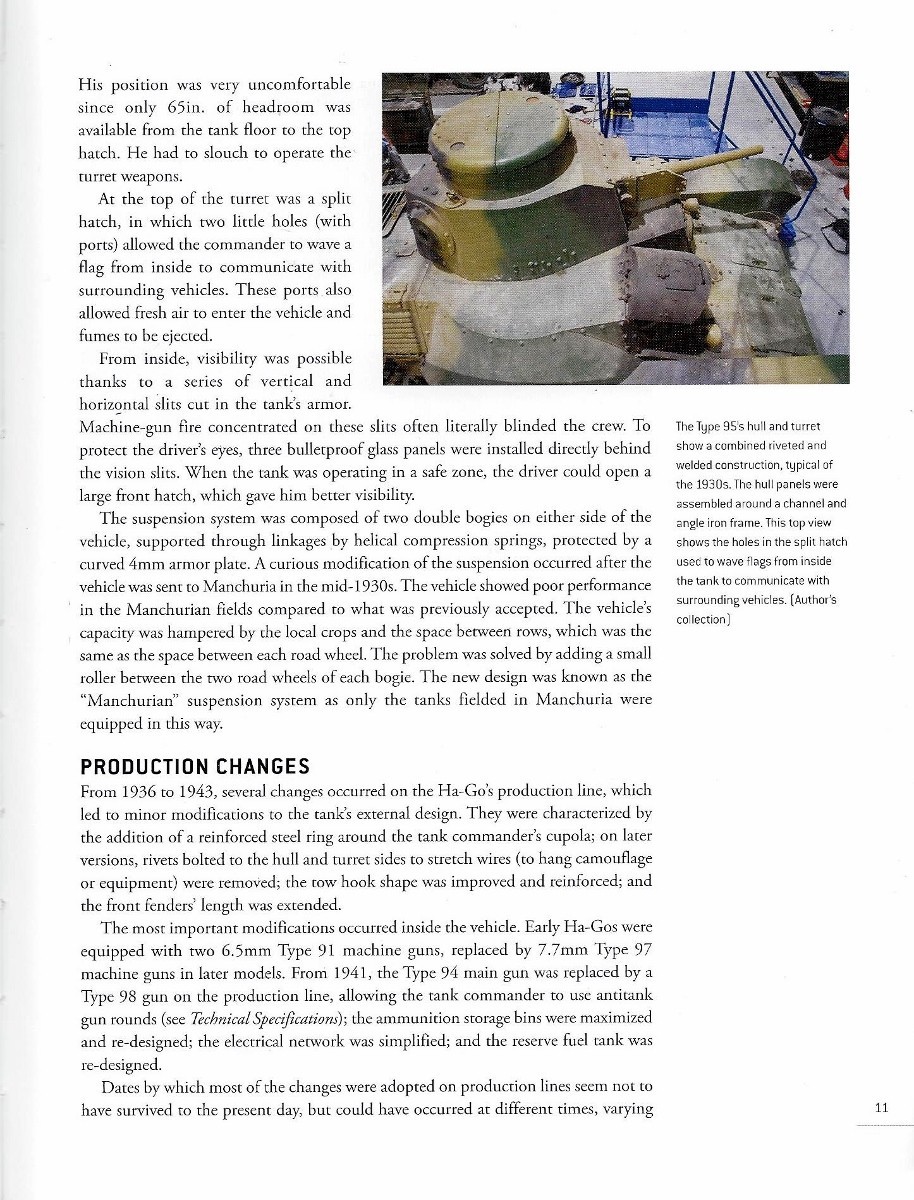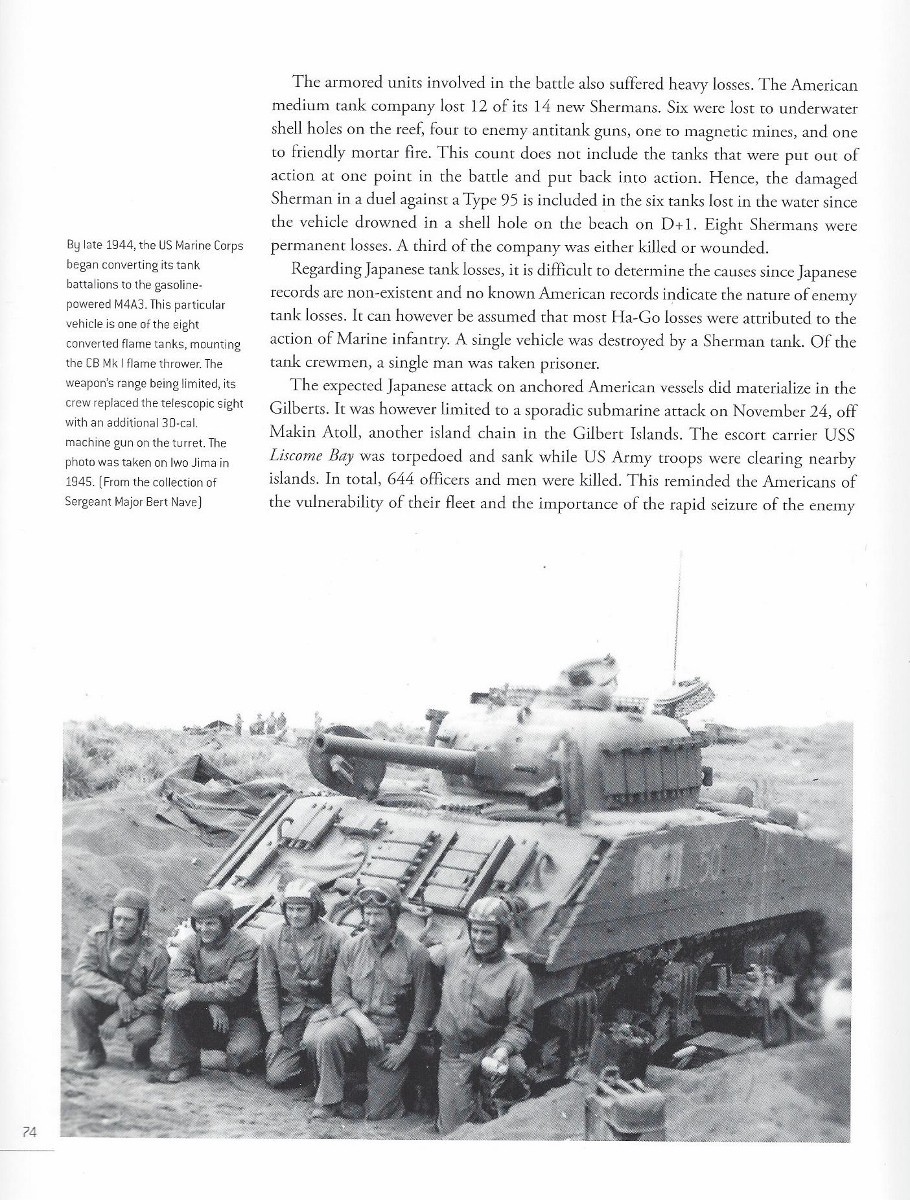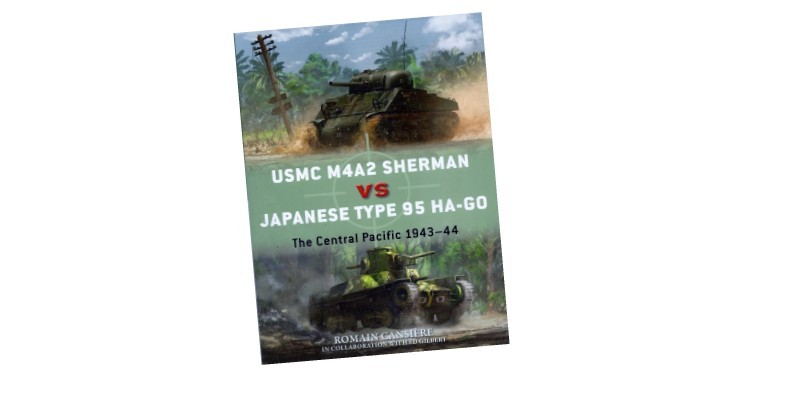
Introduction
USMC M4A2 Sherman vs Japanese Type 95 Ha-Go, The Central Pacific 1943-44 from Osprey Publishing Ltd is authored by Romain Cansière and the late Ed Gilbert, and illustrated by Edouard A Groult. This 80-page book is the108th title of Osprey’s series Duel. It is catalogued with Osprey’s short code GNM 108 and ISBN: 9781472840127. As Osprey describes it:
- The different national tank doctrines of the United States and Imperial Japan resulted in a terrible mismatch of the predominant tank types in the crucial Central Pacific campaign. A flawed Japanese doctrine emphasized light infantry support tanks, often used in small numbers. Tactically, tanks were often frittered away in armored versions of the familiar banzai attacks. Meanwhile, the Americans saw the tank as an infantry support weapon, but developed a more systematic tactical doctrine. They settled upon a larger medium tank - in the case of most Marine Corps tank battalions, the diesel-powered M4A2 (unwanted by the US Army).
This superbly detailed title reveals how both the two sides' tactical and technical differences in the approach to armored warfare soon became apparent over a series of deadly engagements, from the first tank fight at the battle of Tarawa in November 1943, through to engagements on Parry Island, Saipan, and Guam, before ending with Peleliu in September 1944.
Japan was impressed with the potential of tanks after The Great War. Indeed, Japan had the fifth largest armored force in the world in the 1930s. As the civil war in Spain burned, Japanese observers took notes and set to work designing modern tanks from lessons learned. When Japan started hostilities with a China lacking armor and anti-tank weapons, their tanks did well. In the subsequent clash with the Soviet Union, Japan found they severely needed to modernize. Their Type 95 was obsolete and yet being their most numerous tank bore the brunt against American tanks on the jungle and coral islands of the central Pacific.
You can view the book on the Osprey site here.
Content
USMC M4A2 Sherman vs Japanese Type 95 Ha-Go is presented through 10 chapters and sections in 80 pages:
- Introduction
- Chronology
- Design and Development
- Technical Specifications
- The Strategic Situation
- The Combatants
- Combat
- Analysis
- Bibliography
- Index
Inside the title page is a list of abbreviations and a conversion table of imperial to metric. The text is enhanced with firsthand accounts and quotes from both American and Japanese tankers present in the battles recounted. Sergeant Shiro Shimoda tells of his tank company's battle:
- American M4 Sherman tanks suddenly appeared and we opened fire on them, but our shells bounced off them like baseballs owing to their thick armor. Tanks of the 9th Tank Regiment were destroyed one after another, bursting into flames and burning with billowing smoke...
A Marine gunner wrote of another night engagement:
- Both tanks opened fire with their machine guns and, "when one gunner saw his tracers ricochet straight up he let a 75mm HE go, hitting the first tank, it exploded about 20 yards from his tank."
The text is full of such quotes and excerpts from reports, diaries, and other sources.
Twenty-five pages of Design and Development and Technical Specifications describes the various factors for building and equipping these two tanks. It explores and describes preceding designs, and differences in ammunition, armor, communications, engines, gunnery, sights, and weapons and other critical factors.
Eighteen pages of The Strategic Situation and The Combatants describe the background of the battlefields focused upon in this book, and the fighting units that attacked and defended them: Tarawa; Eniwetok; Saipan; Tinian; Guam; Peleliu.
The main event is the chapter Combat, 23 pages of it. Combat on the aforementioned islands is presented by the authors, enriched with a good deal of official reports and first-person narratives referred to above. The accounts are not just of M4s battling Ha-Gos, but also taking out Japanese 5-inch naval batteries, pillboxes, Banzai attacks(by tanks and foot soldiers), and caught by “friendly” naval barrages. The text contains fascinating accounts of fighting in jungle terrain through coral dust and smoke, buttoned-up tanks moving at night, tank crewmen fighting dismounted, Japanese tank charges, armor/infantry close-quarter melees, and other unusual situations. The vulnerability of the two tanks against the other’s gun is interesting and explains why USMC gunners often used high-explosive (HE) instead of armor-piercing (AP) rounds. Finally, Analysis wraps up the results of the fighting and history of US tanks for the rest of the Pacific War.
The text is well organized, very informative and interesting, and easy to read. It does contain a few foibles and flaws. A footnote on page 18 states Marines never used the name “Sherman,” yet pages 71 & 72 hosts these quotes by Platoon Sergeant James D. Burkhalter Jr., and Lt Col. Lewis W. Walt, 5th Marines Executive Officer:
“There were more than fourteen of them and only six of us. I didn’t think they saw us, so I decided to wait until they got almost on us. I knew that with surprise on our side to help us out, our General Shermans would prove more than a match for those Japs.”
“The four tanks played an important role in stopping the tanks and also the supporting infantry, the majority which beat a hasty retreat when these Shermans came charging down from the south.”
Regardless, this is one of the more interesting Duel books I have read. It is reinforced with an exceptional gallery of photographs and artwork.
Photographs, Artwork, and Graphics
This selection of photographs and artwork definitely reinforces the text. Modelers will find many photos to inspire models, dioramas, and worthy of research. For combat conditions an amazing number are excellent and clear images. It has the highest ratio of photos of combat and disabled/destroyed tanks that I recall. Most are black-and-white yet there are several color photos. You will find color photos of a museum Ha-Go with interior views, communication gear, and the infantry cooperation “fake rivet.” One incredible color still is of a M4 cracked open by bouncing 16-inch shell. A couple of photos show unusual multi-color camouflage on M4s.
Artist Edouard A Groult created an excellent gallery of images missed by the camera.
Illustrations
1. Type95 Ha-Go, 9th Tank Regiment, Guam: color three-view illustrations with a table of 11 technical characteristics.
2. M4A2,Tank Company, 4th Marines: color three-view illustrations with a table of 11 technical characteristics.
3. Main gun sight views of the M4A2 and Type 95.
4. View through the Ha-Go machine-gun sight and M4A2 .30-cal. periscope.
5. Main Gun Ammunition with data table:
- a. M48 HE – M3 75mm
b. M72 AP
c. T30 Canister
d. Type 94 AP - Type 94 gun 37mm
e. Type 94 HE – Type 94
f. Type 94 AP - Type 98 gun 37mm
g. Type 94 HE – Type 98
7. Cutaway, USMC M4A2 Turret, keyed to 12 components.
8. Cutaway, Type 95 Ha-Go Turret, keyed to 11 components.
9. Two-page combat scene, US M4A2s encounter Japanese Type 95s on Parry Island, Eniwetok, 22 February, 1944: Circle 2 Cobra sends a Type 95 turret skyward upon a pillar of fire while Type 94 37mm rounds ricochet off a M4 turret.
Tables clearly impart information that would take many pages to convey in text.
1. Sherman Variants Motorization: engines and their origins for the
- a. M4 and M4A1
b. M4A2
c. M4A3
d. M4A4
i. Weight (fused)
ii. Length (fused)
iii. Muzzle velocity
iv. Armor penetration (1,000yd, homogeneous steel, 30˚ obliquity)
v. Weight (fused) [sic]
3. Armor thickness compared, M4A2 and Ha-Go: turret/hull front/rear/sides.
4. Technical capacities compared, M4A2 and Ha-Go:
- a. Combat weight
b. Engine
c. Horsepower
d. Power-to-weight ratio
e. Road speed
f. Fuel tank capacity
g. Range
h. Ground pressure
i. Maximum slope the tank can negotiate
- a. Commander
b. Type 95
c. Type 97
d. Shinhoto
e. Location
7. TO&E USMC Tank Company
8. Tank losses during the Battle for Guam, July 21-August 10, 1944: American and Japanese losses by 12 causes (weapons, suicide squads, terrain, mechanical, etc.)
Excellent photos and artwork enhances this book.




Conclusion
I admit it, Osprey really impresses me with this book and I definitely recommend USMC M4A2 Sherman vs Japanese Type95 Ha-Go, The Central Pacific 1943-44. Modelers with an interest in Imperial Japanese Army armor, Pacific island campaigns, and the M4 Sherman, should find this book to be a valuable addition to their library.
Highs are the informative text and an exceptional gallery of photographs and artwork. Maybe not a low but the contradiction concerning the use of the name Sherman for the M4 makes me wonder about the accuracy of the rest of the content. [Editors Note: for more on this you can see the authors comments below in the comments area.]
Regardless, this Duel is one of my new favorites and I think you will like it, too.
Osprey released other books that compliment this title:
- M4 Sherman vs Type 97 Chi-Ha - The Pacific 1945
- Japanese Tanks 1939-45 New Vanguard #137
- US Marine Corps Tanks of World War II, New Vanguard 186
Please remember to mention to Osprey and retailers that you saw this book here -on Armorama.


























